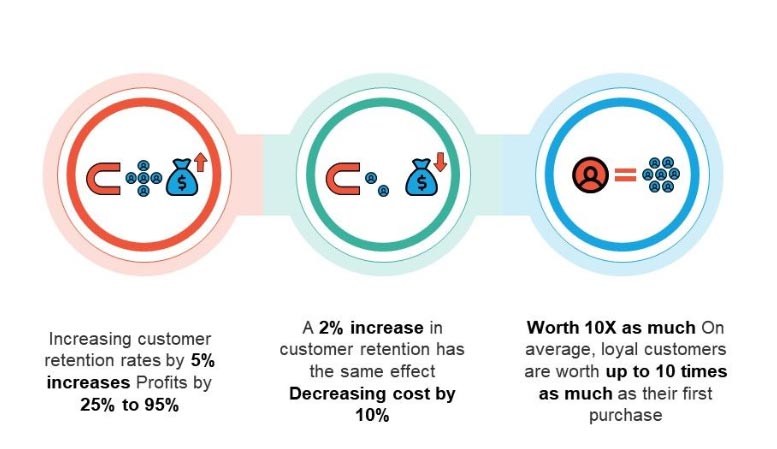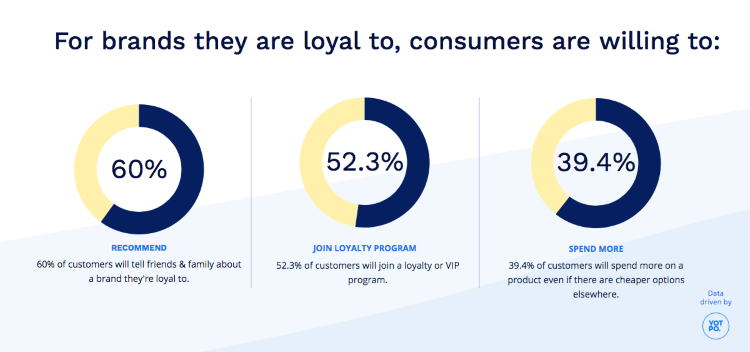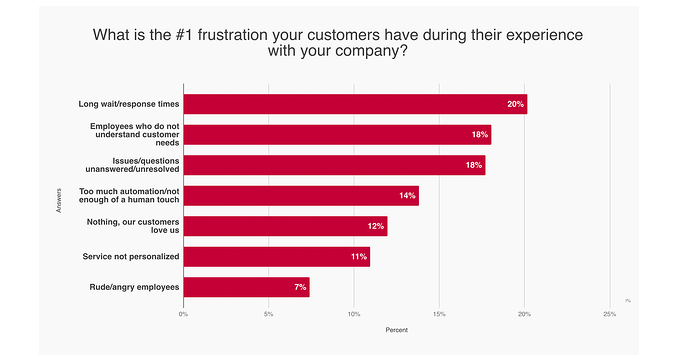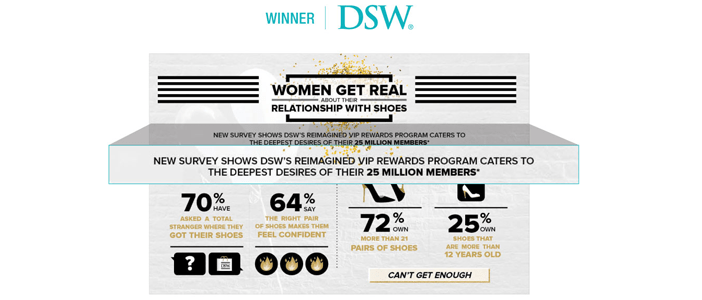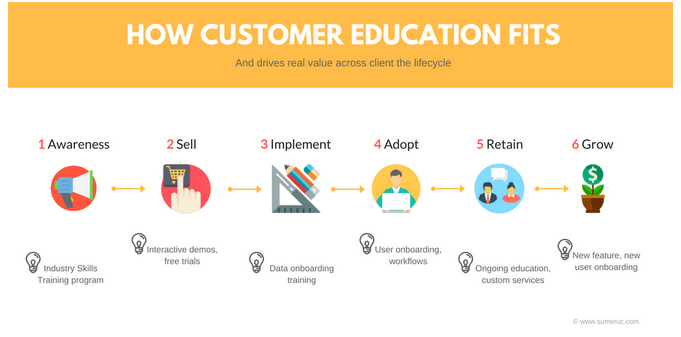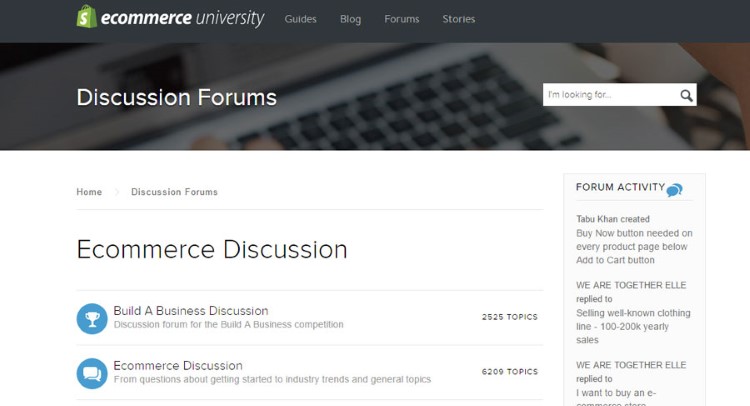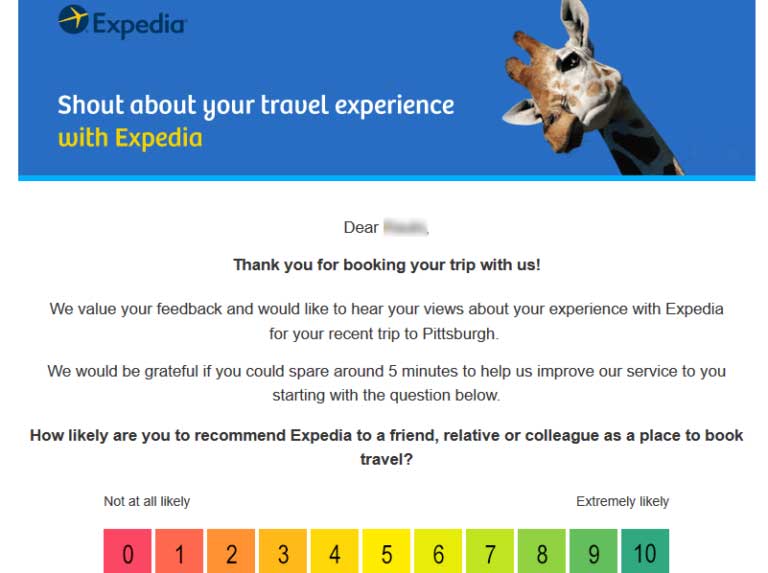15 Effective Customer Retention Strategies from Top Brands
- June 13, 2018
- 27 mins read
- Listen
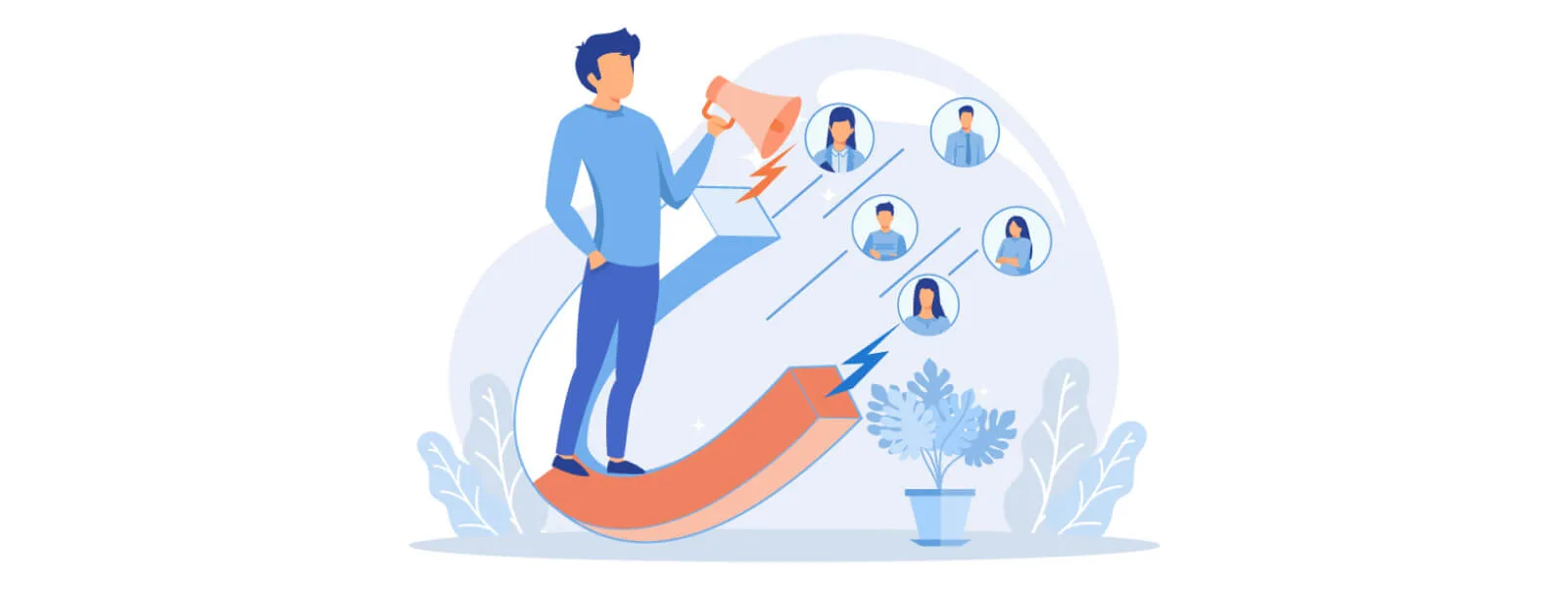
Table of Content
One of the biggest pitfalls for businesses across the globe is the thought of having a great product or service is enough as a strong customer retention strategy. The bitter truth is that it is only one aspect of marketing while there are many more strategies on how to retain customers.
While every business needs new clients, it is equally critical to improve customer retention as acquisition costs are five times more than retaining an existing customer.
Customer retention is a blend of art and science.
The art is to create & foster significant customer relationships by investing in extra efforts to go above and beyond your customer expectations.
The science behind customer retention is understanding their journey, ensuring consistent assistance from all touchpoints, and equipping your team with tools to deliver an extraordinary customer experience (CX).
According to the SmallBizGenius, almost 65% of a company’s business comes from repeat customers.”
So what does client retention mean? And how to retain customers with different relationship-building strategies?
Let’s explore the key concepts and examples of how you can build a successful client retention strategy to scale your business.
What is customer retention strategy?
Customer retention is defined as the ideas and strategies that an organization should implement to keep their customers stay with their brand. The key goal behind having a successful client retention plan is to help businesses to retain customers and how they contribute to the growth of the business.
A good customer retention strategy always begins with the first contact a customer has with your business and continues throughout the lifetime of the relationship. Having a good understanding of consumer motivations is always a building block of customer retention.
Why is customer retention marketing important?
The success rate of selling to an existing customer is 60-70%, while the success rate of selling to a new customer is only 5-20%.
Understanding the aspect of customer retention for turning them into brand loyalists will be crucial to fueling your business through the ups and downs. Implementing retention tactics and ideas can significantly impact your business in three key ways.
- Cultivate customer loyalty – The right client retention programs help you create an experience that not only satisfies your customers but also engages them in a more meaningful interaction with your brand, forging loyal relationships.
- Increase customer lifetime value (CLTV) – Increasing customer retention rates by 5% increases profits by 25% to 95%. Hence any business that wants to grow its bottom line, needs to equally focus on retaining customers as well acquiring customers for sustainable growth.
- Build positive word of mouth – The best customer retention analysis and tactics enable you to develop lasting customer relationships that become loyal to your brand. Eventually, they might even turn out to be your brand ambassadors and spread positive word of mouth.
15 retention strategies on how to retain customers from top brands
Customer retention strategies work parallel to deliver great experiences that develop loyalty and encourage customers to stay associated with your brand for a lifetime. Retaining customers not just obtain more value from a product but also encourage them to share their feedback and experiences to influence new customers.
We have narrowed down the list of strategies for an effective customer retention program.
- Make customer experience (CX) a strategic priority
- Respond to customer issues instantly
- Deliver real time customer engagement
- Create well-tailored customer retention program
- Implement customer feedback judiciously
- Deliver consistent omnichannel customer service
- Map your customer journey
- Delight your customers always
- Create interactive content for educating customers
- Listen & empathize with your customers
- Maintain customer communication with newsletters
- Build community to enhance customer relationships
- Keep a track of customer retention metrics
- Assist proactively to improve customer retention
- Leverage employee engagement
Let us discuss the key strategies on how to retain customers and convert them as brand advocates.
1. Make customer experience (CX) a strategic priority
Everything you do impacts your customers’ perception and their decision to return back to your business or not.
If you create a good experience, that is consistent and predictable, then you have a right shot at improving and setting good customer retention examples.
Customer experience comprises all the touchpoints with your business starting from website navigation, customer service interaction to the final purchase.
Thus, a great customer experience is your key to success. The unforgettable customer experiences are the ones that create an emotional connection with customers. Businesses that use emotional connections outperform their competitors by 85% in sales.
How making the customer experience the focal point can increase customer retention
- Improve customer satisfaction – A satisfactory interaction with your brand undoubtedly creates a great impression and experience that encourages customers to retain your business.
- Convert first-time customers to loyal customers – When customers are delivered consistent service they are delighted with the experience and develop loyalty towards your brand.
- Improves customer advocacy – Happy customers not only have high lifetime value but also turn out to be the best brand advocates. They share their experience with their friends to improve brand credibility.
Zappos is a popular online shoe store that helped a customer during an unfortunate scenario. He was late returning a pair of shoes due to a death in the family.
Source: chattermill
The Zappos’ customer service team went the extra mile to take care of the return shipping and arranged a courier to pick up the shoes at no cost. They also sent the customer a bouquet and a note offering their condolences.
The unforgettable customer experiences are the ones that create an emotional connection with customers. Businesses that use emotional connections outperform their competitors by 85% in sales.
They offered service along with the human touch.
Creating connections with customers starts with listening. It shows that you care, and you will also be able to uncover their needs, challenges, and pain points.
Best practices:
- Always listen to your customers to discover their needs, challenges, and pain points.
- Keep your customer service as human as possible, whether you do it online or in person.
- Try to connect with your customers emotionally in order to win their loyalty to your business.
2. Respond to customer issues instantly
The primary reason for the bad customer experience is “LONGER RESPONSE TIME”.
Implementing live chat can be one of the best customer retention strategies and significantly reduce the impact of the factor that adversely affects the customer experience.
59% of customers are more likely to buy when brands answer their queries in under a minute. Customers become loyal to your brand and retain for a long time period.
How live chat can be a good customer retention idea?
- Immediate assistance – It helps to provide instant solutions to all the sales and support-related queries. By routing the conversation to the right support team the queries are solved faster.
- Boost customer satisfaction – It drives customer satisfaction by reducing wait time and converts visitors to loyal customers who not only retain with your brand but also advocate positive word of mouth.
- Proactive customer engagement – You can engage customers proactively in the right direction before the doubt becomes a big problem.
Source: Hotjar
Best Practices:
- Resolve your customer queries instantly with live chat as they demand immediate response when it comes to customer service.
- An immediate response helps in more sales conversation and retain customers with your business.
REVE Chat is a popular platform that offers a suite of customer engagement platforms essential for delivering quick responses. Sign up to get the best of support software and start delivering instant responses.
3. Deliver real time customer engagement
Businesses that empower their customer support team with live customer engagement such as co-browsing and video chat can deliver faster solutions in the first contact. The live engagement tools reduce the number of customer touchpoints and deliver effective solutions in the first go.
By using the visual tools, you can guide them through the complex form-fill process, make onboarding seamless, and provide a virtual in-person experience.
Customer engagement tools can be one most preferred client retention strategies. Let’s see how.
- Personalized support – Having a face-to-face interaction encourages personalized conversations and removes all fears and frustration settles faster, thus, building personal and reliable customer relationships.
- Improve customer experience – With instant response, you reduce the number of customer touchpoints. Live sessions have a great impact on customer satisfaction. With co-browsing, you can deliver interactive real-time experiences to your customers.
Commercial Bank of Kuwait (CBK) for example, implemented REVE Chat’s co-browsing and video chat solution. Their main goal was to increase user engagement through online banking operations and deliver an advanced digital banking experience.
The bank has marked an increase in online engagement and reduced the number of touchpoints to resolve the issues.
Best Practices:
- For communicating the technical concepts and complex form fill-up, combining video chat and co-browsing can deliver effective solutions.
- You can develop friendly communication with customers that positively impacts customer relationships and deliver faster responses in real-time.
4. Create a well-tailored customer retention program
It requires a comprehensive understanding of your customer base and a strategic approach to fostering long-term relationships. You can start by analyzing customer data to identify key preferences, behaviors, and pain points. You need to utilize this information to segment your customer base and personalize communication and incentives accordingly.
Implementing a multi-channel communication strategy, including email campaigns, personalized offers, and targeted social media engagement, can help maintain a consistent and meaningful connection with customers. Also, you should consider incorporating a loyalty program that rewards repeat business and customer referrals.
Additionally, regularly gather feedback through surveys or other means to understand customer satisfaction and areas for improvement. You cannot ignore the fact that proactive problem resolution and excellent customer service are crucial elements of any retention program.
Finally, stay adaptable by continuously monitoring customer trends and adjusting your strategies to meet evolving needs. You can build a customer retention program that strengthens loyalty and contributes to sustained business success by combining data-driven insights with personalized engagement and a commitment to customer satisfaction.
The key ways loyalty programs help in customer retention marketing are:
- Customer retention programs are inexpensive to implement but can significantly increase customer lifetime value (CLTV).
- An effective loyalty program helps you to identify your brand ambassadors who have turned out to be your loyalists and spread the word-of-mouth virality.
To foster better customer relationships, customer retention programs can be highly beneficial in giving frictionless experiences.
DSW runs a loyalty program that rewards customers with points for each purchase and includes tiers of rewards that customers can unlock as they spend more. Their program runs seamlessly.
If customers forget about the loyalty program, DSW keeps customers engaged with the program and reminds them where they stand and what they could earn by spending more at DSW stores.
Best Practices:
- You should define your business goals clearly and pick up the right actions to handle customers.
- Exceptional customer service is a cornerstone of retention. Promptly address customer concerns, be proactive in problem resolution, and strive to exceed expectations.
- Keep your focus more on customers instead of products or services.
- You should stay engaged with customers after the initial purchase. Implement post-purchase communication, such as follow-up emails or surveys, to show appreciation and gather insights. Create an effective and enjoyable customer experience at every touchpoint, from browsing your website to receiving products or services.
- Monitor and learn your customers’ behavior from the data and try to go beyond their expectations.
5. Implement customer feedback judiciously
“Your most unhappy customers are your greatest source of learning.” Bill Gates
And the easy way to know if your customers are happy or unhappy with your products and services is by having regular customer feedback. Customer feedback is vital for every business and an important factor that determines the growth of your business.
Customer complaints or feedback provide you the customer’s perceptions about your overall business. They also give a clearer view of how you are performing. Collecting feedback requires asking customers to share their feedback about the product, service, or about their overall experience.
The best time to ask for feedback from customers is right after a customer service conversation. Collecting feedback becomes effective when you analyze and act upon it.
Best Practices:
- Categorizing the feedback comments collected from customers for sending to concerned departments. Divide them into categories that deserve their own branding and attention into subcategories.
- Consolidate all the results and make a plan of action as to how you intend to respond to each of the issues raised.
- Hire well-trained support reps to ask feedback questions at the right time, choose the right channel to ask feedback to customers, tailor the feedback questionnaire, and direct the feedback questions to the right team.
6. Deliver consistent omnichannel customer service
Customers expect contextualized engagement and seamless transitions between channels like phone, social channels, and websites. Businesses that engage their customers by understanding their journey and needs can deliver a personalized service experience.
When you understand how customers interact with your brand across multiple channels, you can optimize your processes to reduce customer frustration and bridge the gaps in the process. It increases customer satisfaction and acts as a great customer retention solution.
How to improve customer retention programs by going omnichannel?
An omnichannel approach in customer retention programs can significantly enhance the overall customer experience and strengthen customer loyalty. Here are some strategies to improve customer retention by going omnichannel:
-
Consistent Messaging Across Channels: It ensures a seamless and consistent message across all channels, including online, mobile, social media, and in-store. Consistency helps in reinforcing brand identity and builds trust with customers.
-
Unified Customer Data: You can integrate customer data from various channels to create a unified customer profile. This comprehensive view allows for personalized interactions and a better understanding of individual customer preferences and behaviors.
-
Multi-Channel Communication: You should always implement communication strategies that span multiple channels. You can use email, social media, mobile apps, and other channels to engage with customers. Also, personalize messages to suit each channel’s unique characteristics while maintaining a cohesive brand voice.
-
Personalization: It provides personalized experiences. You can use past purchase history, preferences, and browsing behavior to tailor recommendations, promotions, and content across all channels. Customers are more likely to stay engaged when they feel a brand understands and caters to their individual needs.
-
Omnichannel Loyalty Programs: You can extend loyalty programs across multiple channels. It allows customers to earn and redeem rewards whether they shop online, in-store, or through a mobile app. This encourages engagement across different touchpoints.
-
Customer Service Integration: It ensures that customer service representatives have access to a customer’s complete history and can provide consistent support regardless of the channel through which the customer reaches out.
-
Real-Time Analytics: It helps to track customer interactions and behaviors across channels. This allows for immediate adjustments to strategies based on customer responses and preferences.
-
Mobile Optimization: Many customers use smartphones and tablets to interact with brands. So ensuring a seamless mobile experience is crucial for an effective omnichannel approach.
-
Feedback Collection: You can collect customer feedback across channels to understand customer satisfaction and identify areas for improvement. Also, use surveys, social media listening, and other tools to gather insights into customer sentiments.
Best Practices:
- You can collect customer feedback to know whether your customers are satisfied or not. Accordingly, you can improve the support process and exceed customer expectations.
- When businesses deliver omnichannel customer service, the number of customer touchpoints is reduced by reaching them across various channels.
8. Map your customer journey
Mapping your customer journey or buyer journey mapping helps to identify, structure, and improve the complex interactions that customers experience across their journey. This makes your business customer-centric and builds customer loyalty.
Analytics helps you to understand the steps customers go through while interacting with your company to reduce the operational and communication gaps.
When the customer experience escalates with your superior service it can lead to a 30% – 50% increase in KPIs such as the likelihood of renewing or purchasing another product.
Best Practices:
- Carry out research to validate the customer journey while identifying key opportunities to add value and build customer loyalty and engagement.
- Understand how the customer journey research can help to shape ongoing customer retention solutions.
9. Delight your customers always
Customer delight is an excellent customer retention tip, which means businesses should go the extra mile to fulfill their customers’ expectations and deliver a delightful experience.
But how would you know that customers are delighted? The answer is simple, by listening to them and understanding their needs.
Never miss out on any opportunity to surprise your customers. Try to deliver better service at a lower cost, and do more than they were expecting. Treat them as special people and you will for sure improve customer retention programs.
How to increase client retention by delighting customers?
- When you anticipate customer needs and align your products and services to their interests, they are happy that they are valued and listened to.
- Putting genuine efforts to deliver good experiences to customers pays back well. They choose to remain with your business for a longer time.
- Delivering consistent support across all channels always impresses customers as it is one of their top expectations.
- Know the top issues your customers are facing through surveys and social channels, and take active steps to fix them.
Customers are ready to pay more for a better experience, and better quality which is proved by the fact that 55% of consumers would pay more for better customer experience.
Best Practices:
- Personalize your conversations with customers to develop trust and loyalty.
- Not just collect but analyze the customer feedback values and customer comments.
- Connect with your customers in real-time over their preferred channels.
10. Create interactive content to educate customers
Educating customers refers to the effort a company takes to provide authentic knowledge to customers to use their products or services. The content created should be interactive and easy to understand by the customers to get started with.
Customer education turns effective when they choose to be associated with your company. They become loyal, and your loyal customers also turn into your brand ambassadors. It empowers customers with knowledge and gives insights about the product to help them to understand the product.
Here is how educating customers can act as a great customer retention solutions?
- It helps to develop a better understanding of your brand, which gives customers better clarity about your products and services.
- Customers can find information and solutions about FAQs, which reduces the number of customer complaints.
- It helps to build trust and loyalty towards your brand as they find integrity between the information and practice.
Source: sumeruc
Best Practices:
- You can offer product demos for your products and services. It helps to understand the product better and start a conversation.
- Try sharing content in different ways such as updating announcements through your website, via email newsletters, blogs, social media content, etc.
- You can organize workshops and try to connect with your customers emotionally.
11. Listen & empathize with your customers
“One-time customers aren’t going to fuel the continued growth of your business. Retaining customers is crucial to your long-term business success”
Businesses that put efforts into understanding that what customers are actually looking for, help them to offer the right product, service, or solution. Practicing a listening culture is a great retention strategy for customers.
Thoroughly listening to customers helps you to develop empathic abilities. An empathetic statement has a good impact on customers and the feeling that you are able to understand their problem.
However it is difficult to help customers who are not receptive.
What should you say to customers who express unhappiness or anger?
While such situations are quite sensitive to handle, using well-designed chat scripts for different scenarios can help to deal with all kinds of customers. The consistent response helps to resolve the customer issues and settle him down to normal.
Best Practices:
- Learn about your customer experience with your products and services. Listen to them and identify their needs.
- Train your customer support employees with soft skills – handling customers with patience, politeness, and pleasingly.
- Provide transcripts to the support team to use during customer service interactions.
12. Maintain customer communication with newsletters
Email newsletters are one of the best ways to stay connected with customers and build lasting relationships with them. It proves to be one of the best customer retention strategies and help businesses to attract new prospects and also retain them with your business.
Businesses that look forward to nourishing customer loyalty, must keep their email subscribers in the loop on the latest and greatest news from their brand.
How to retain customers with newsletters?
- When you launch a new product or feature, you can send emails to update them about the recent add-ons to your brand.
- Email newsletters allow you to send targeted information to your audience, helping customers feel catered to and encouraging them to engage more with your brand.
- You can segment your email lists to send personalized newsletters. You can sort the list into groups based on factors like purchase history and age demographics, then cater each newsletter to each group.
Thus, you can show customers products or news on what they may be interested in. Following such ways to engage customers can be the best retention tactic, any business can follow. They prefer choosing your brand over others and stay linked with you for a longer time.
Best Practices:
- Keep your focus on benefits parts as customers are not really concerned about a specific feature added. Instead, they want to know how it will help them achieve their goals.
- Make use of good content and eye-catching visuals to convey your message to your customers.
13. Build a community to enhance customer relationships
People enjoy the feeling of belonging to a community or group. You as a business can supplement such positive feelings through community management, or by creating a user community that benefits your customers.
Having a community will allow your customers to discuss important topics and ask questions about your products and services.
When customers feel connected to your brand, they tend to show it through repeat purchases and word-of-mouth marketing—all of which help you build and grow a loyal customer base.
Shopify, the leading global eCommerce solutions provider has a discussion board. The community is a hub for information exchange on a global scale. The Shopify store owners can use it to engage with other store owners
Building a community can be an excellent customer retention solution in the following ways:
- You can build a loyal relationship with your customers that give your loyalists a place to connect with the brand and with each other.
- It acts as a knowledge base where your loyalists can share tips and tricks for optimizing the product.
No matter how your community might be used, as a resource for sharing useful information or as a medium for users to submit customer reviews, fostering a space where customers can interact with one another and your team adds value to your customer experience and continues to delight them.
Best Practices:
- Having a community is an essential tool for customer education but is it important to moderate the conversations in order to avoid irrelevant discussions that would dent your brand.
- The community develops a sense of belonging in customers to your brand. They decide to stick to your brand for a lifetime.
13. Keep a track of customer retention metrics
In order to maximize your efforts on customer retention strategies, you need to understand how to track and measure some key retention metrics. When you know how to calculate the key metric, you can begin to put them to work in your own store for lasting, profitable results.
Key customer retention metrics are as follows:
- Attrition rate – It helps in knowing your churn rate and helps you determine what steps to take when developing a retention strategy.
- Repeat customer rate – Your repeat customer rate is simply the percentage of your customer base that has made more than one purchase. Loyal customers are the ones who make repeat purchases.
- Customer lifetime value (CLV) – CLV indicates how much your customers are spending during their customer lifecycles. When your customers are loyal, they tend to spend more, yielding greater lifetime value.
Measuring the retention metrics can help you identify, which are the strategies that are performing well and the ones that need improvement. Tracking the metrics helps you to retain your customers before they become your ex-customers.
Best Practices:
- You have to measure your customer retention metrics regularly to understand the retention techniques that are performing well and those that need to be modified.
- When you know the ways your customers like to be served, craft the engagement plans in a similar way to make your service effective and help retain customers.
14. Assist proactively to improve customer retention
You can proactively assist your website visitors and customers by using all the customer data you have. Analyzing the data will help you to understand your customer needs and assist accordingly to improve customer retention.
For example, you should know how the tips for SaaS customer success often lie in knowing that customers are constantly getting stuck at a certain point. You can create triggers that will automatically send them messages to walk through that issue they are facing.
Best Practices:
- You will incorporate that feedback into the product to ensure that your customers don’t get stuck at that particular point.
- SaaS is different because almost all the interactions are digital and measurable but the principles of being empathetic to your customers’ needs remain the same, no matter what business you are in.
15. Leverage employee engagement
As a part of their client retention programs, businesses have to go beyond products and prices. What they need to do is leverage their most under-utilized assets i.e. employee base. When the employees are engaged they deliver personal customer experiences that create customer loyalty.
Gallup study about employee engagement says, a U.S. workforce with only 30% of employees engaged in their work, with active disengagement costing the American economy an estimated $450-550 billion per year.
The best example for employee engagement – Southwest Airlines
Southwest Airlines grabbed the top rank in building an excellent work ambiance and culture to make their employees happy and comfortable. They created a healthy work environment for employees comprising teamwork, work values, and motivation.
Best Practices:
- When you value your employees, they are ready to go the extra mile for you and deliver the best customer service experience.
- It is important to make employee training an integral part of your company culture to make them aware of your company’s vision and customer engagement strategies.
Customer retention examples
Many businesses across different industries have invested time and money to deliver a great experience to their customers and retain their customers for a longer time.
Here are some examples of companies that made extra efforts and built smart strategies to create successful customer retention examples
#1. Customer retention strategy example – Expedia (Ask the customer for feedback)
It’s important to know how customers feel about your brand. That way you understand what is working, what is not, and how you can improve.
Whether through surveys or customer interviews, feedback is the best way to get insight into the things that customers like and dislike about your brand.
Expedia uses automation to collect feedback from customers once their trip has ended. Automating the feedback process helps it become a consistent and informative part of your business practices.
#2. Customer retention example – Ellevest (Reward referrals)
Rewards get customers to return to your brand, but they can also get customers to send new customers to your brand.
Create a referral program that rewards customers when they spread the word about your brand and lead family and friends to your business. Make the program even more effective by giving rewards to both the referrer and referee.
To drive new customers to use their financial services and reward existing customers for referring them, Ellevest implemented a program that gives both parties a $50 credit in their account in exchange for a referral.
#3. Customer retention strategy example – Buffer (Share company’s update and news)
Keeping customers in the loop is another way to build trust while bringing consumers closer to your brand. As your company makes changes, let customers know by publishing blog posts or sending newsletters that update them on company news.
Buffer, a social media marketing provider, is a prime example of this customer retention strategy. Their Inside Buffer blog discusses operations and changes within the organization to make customers feel closer to the brand.
Key customer retention metrics
If businesses want to maximize their retention efforts, they need to understand how to track and measure some key retention metrics. Once they know how to calculate them, it is easy to get profitable results.
Growing companies prioritize customer success more than stagnating ones and increasing retention by 5% actually increases profits anywhere from 25% to 95%.
Here are the key retention metrics that have a huge impact on revenue and growth.
- Customer Churn Rate (CCR) – By understanding why customers leave when they leave, and how they leave, you can optimize the customer experience for the ones you are still subscribers so they don’t churn.
- Customer Lifetime Value (CLTV) – This metric shows the value of every customer and the revenue you can generate if customers are retained and continue to pay.
- Customer Acquisition Cost (CAC) – CAC is a fundamental metric that helps you to understand your target market and the ROI of your existing acquisition strategies and channels.
- Net Promoter Score (NPS) – A high NPS doesn’t automatically guarantee customer retention and growth. But when analyzed alongside revenue growth rate and customer churn rate, you can predict possible growth from retention and referrals.
How to Calculate Customer Retention Rate?
Customer Retention Rate (CRR) is a metric that measures the percentage of customers a business retains over a specific period. To calculate the Customer Retention Rate, you can use the following formula:
Here’s a step-by-step breakdown:
-
Determine the number of customers at the start of the period (CS): This includes all the customers you had at the beginning of the time frame you’re measuring.
-
Identify the number of new customers acquired during the period (CN): Count all the new customers you’ve acquired during the specified time frame.
-
Find the number of customers at the end of the period (CE): This includes all customers you have at the end of the time frame.
-
Apply the formula: Subtract the number of new customers acquired during the period from the total number of customers at the end of the period. Now divide this result by the number of customers at the start of the period, and multiply by 100 to express the rate as a percentage.
A simplified version of the formula is:
A high Customer Retention Rate indicates that a business is successful in retaining its customers. A low rate may suggest that the business is struggling to keep customers over time. Monitoring this metric is crucial for assessing the health and sustainability of a customer base.
Final thoughts on how to retain customers
With well-designed client retention strategies, you can understand your customer needs and improve loyalty. You have to deliver extraordinary customer service and develop interpersonal courtesy to treat customers positively. Sign up to get advanced customer service tools and deliver quick responses to customers.
Make your customers feel they are part of your business by taking their opinions. Implement their suggestions and acknowledge them to achieve the customer success they deserve.
What customer retention strategies do you think work best for your business? Please share it with us!

